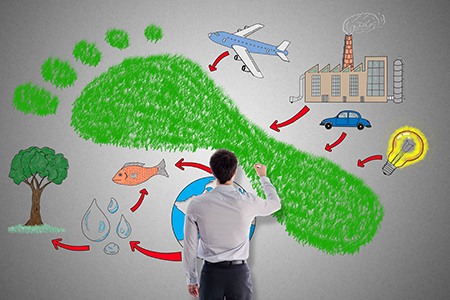

It can be wise to run your business in a lasting and responsible way—to position it to take advantage of opportunities, benefit financially and leave behind a positive legacy. In developing an environmental sustainability policy, you must first look at your own operations and evaluate your ecological footprint. Your sustainability strategy should define business drivers that cover sustainability areas across your business.

Steps your company can take in evaluating your ecological footprint:
Examples of areas you might decide to improve:
1. Vision: Your vision statement should be a sentence of approximately 10 words that concisely describes your ideal outcome, product or service.
2. Principles/Core Values: Include a list of principles that are most relevant to
your business and/or align with company core values to help guide your response to an opportunity or challenge in a way that aligns with your sustainability vision
3. Important Issues: Which issues in the world are most important
for your organization to address? Example: Due to the direct impact on our business, we have prioritized the following sustainability issues to be addressed: water and energy conservation.
4. Commitment & Scope: At times, your
ability to act on your policy can be affected by what you control and influence, so your policy should clarify boundaries and scope.
5. Objectives: It is imperative to have time-related achievable targets with deadlines. An Action Plan will help to ensure that the policy is effective and doesn't become 'another piece of paperwork.' Your commitment should
be broken down into key objectives that are SMART:

Your operational policies and projects can be more specific regarding how you apply these objectives. Strong sustainability policies will also detail how each objective is measured by identifying an indicator and a target. Establish metrics to measure and track your policy. Try to make your targets reasonable and achievable so you can obtain your goals and build on successes.
Sustainability Policy Objectives Examples:
6. Reporting: State your intention to report progress against your sustainability goals. Make your policy viewable in your work area and on your website and re-visit it at least once a year. It's good for the environment and good for business.
All organizations have suppliers, and if you are a major client, you have the weight to encourage suppliers to implement an Environmental Policy of their own. You could build this into your policy’s targets, thereby demonstrating that you are looking beyond simply your organization’s direct environmental impact.

If you would like to review Ascentium Capital's sustainability policy, click here to request a copy.
---
If you're looking to invest in your business for a sustainable future, Ascentium Capital
can help. We specialize in helping SMBs with all major business initiatives – from conversion to energy efficient LED lighting to environmentally
friendly technology solutions – let us help you get your “Green Campaign” in motion.
Fill out our contact form and a finance manager will be in touch soon!

Leave a Reply
Leave a ReplyYour email address will not be published. Required fields are marked*